
The enigmatic carving discovered at Rosslyn Chapel has been a subject of fascination for many, leading to various speculations of the Rosslyn carving’s Templar connection. This carving (shown above) features what appears to be two riders on a single horse, which has sparked discussions about a possible connection to the Knights Templar, given the image’s resemblance to the Templar seal.
Numerous authors have sought to use this carving as evidence of a Templar presence in the Scottish Chapel. While the resemblance is intriguing, closer examination reveals an alternative interpretation. If we carefully analyze the carving, we can see that the second figure is positioned behind the knight on the horse, as opposed to being mounted on the horse alongside the knight.
While this observation may challenge the Templar theory associated with the carving, it is essential to remember that speculative theories are often not grounded in pure logic. Instead, they are driven by curiosity and a desire to uncover hidden connections.
The truth behind the carving is less fantastical than some theories suggest. The so-called second rider’s leg is, in fact, the tail of the horse, which has been mistakenly identified as a separate figure. This realization brings us back to a more plausible understanding of the carving.
While the carving’s imagery may not directly confirm a Templar connection, it still holds cultural and historical significance. Rosslyn Chapel itself is an architectural marvel, with intricate carvings and symbolic representations woven into its design. Each element within the chapel contributes to a captivating narrative that has captured the imagination of visitors and scholars alike.
Unraveling the mysteries of historical artifacts requires careful analysis and a discerning eye. While the idea of two riders on a single horse may have sparked the imagination of Templar enthusiasts, it is crucial to approach such interpretations with a critical mindset.
In conclusion, the carving at Rosslyn Chapel, while intriguing and open to multiple interpretations, does not conclusively confirm a direct Templar connection. Instead, it serves as a testament to the rich history and artistic complexity of this remarkable chapel. As we continue to explore and uncover the secrets hidden within historical artifacts, let us do so with both fascination and skepticism, ensuring that our findings are based on evidence and reasoned analysis.
About Us
We hope you enjoyed this explanation of the Rosslyn carving’s Templar connection.
TemplarHistory.com was started in the fall of 1997 by Stephen Dafoe, a Canadian author who has written several books on the Templars and related subjects.
Read more from our Templar Mysteries Archives – Templar History
